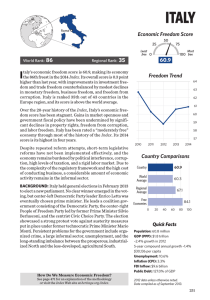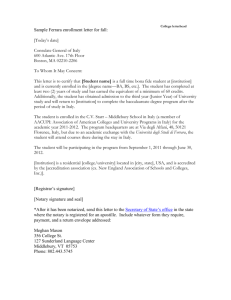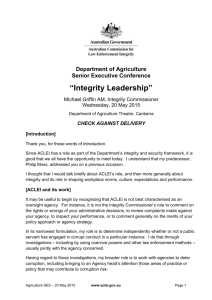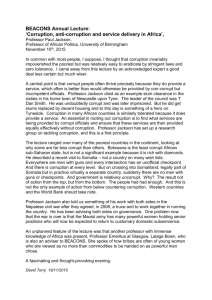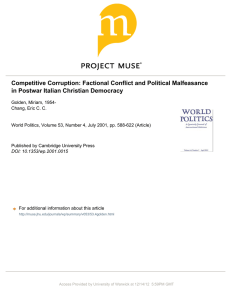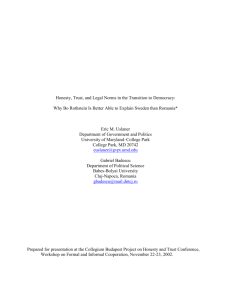IN SEARCH OF REGULATORY NEUTRALITY:
advertisement
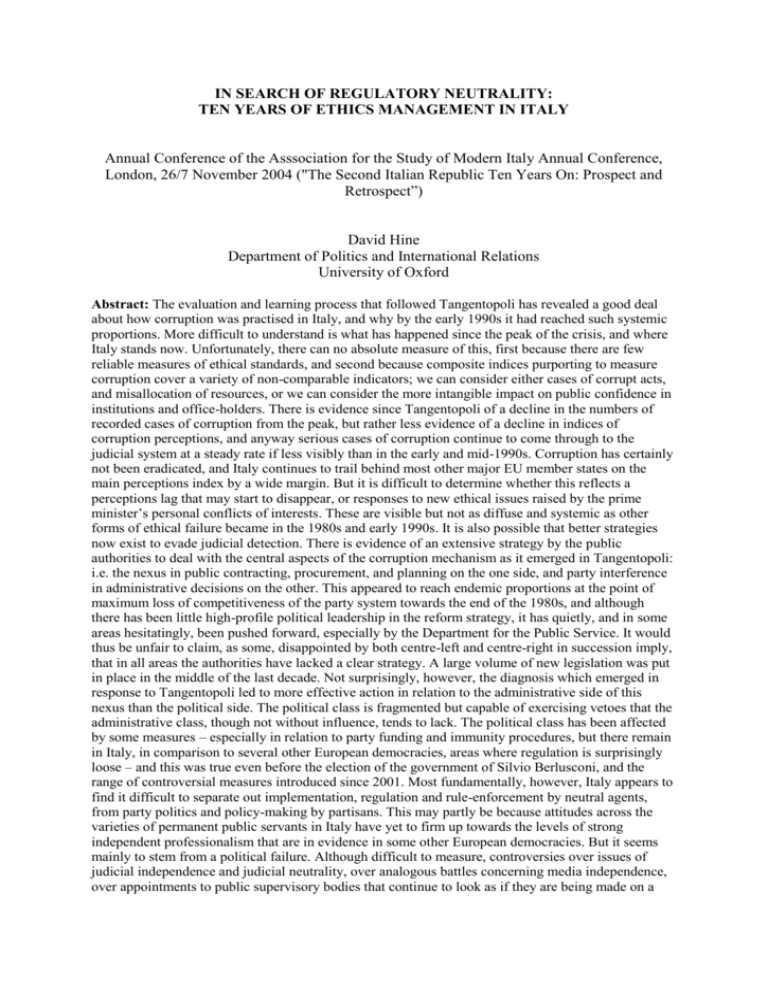
IN SEARCH OF REGULATORY NEUTRALITY: TEN YEARS OF ETHICS MANAGEMENT IN ITALY Annual Conference of the Asssociation for the Study of Modern Italy Annual Conference, London, 26/7 November 2004 ("The Second Italian Republic Ten Years On: Prospect and Retrospect”) David Hine Department of Politics and International Relations University of Oxford Abstract: The evaluation and learning process that followed Tangentopoli has revealed a good deal about how corruption was practised in Italy, and why by the early 1990s it had reached such systemic proportions. More difficult to understand is what has happened since the peak of the crisis, and where Italy stands now. Unfortunately, there can no absolute measure of this, first because there are few reliable measures of ethical standards, and second because composite indices purporting to measure corruption cover a variety of non-comparable indicators; we can consider either cases of corrupt acts, and misallocation of resources, or we can consider the more intangible impact on public confidence in institutions and office-holders. There is evidence since Tangentopoli of a decline in the numbers of recorded cases of corruption from the peak, but rather less evidence of a decline in indices of corruption perceptions, and anyway serious cases of corruption continue to come through to the judicial system at a steady rate if less visibly than in the early and mid-1990s. Corruption has certainly not been eradicated, and Italy continues to trail behind most other major EU member states on the main perceptions index by a wide margin. But it is difficult to determine whether this reflects a perceptions lag that may start to disappear, or responses to new ethical issues raised by the prime minister’s personal conflicts of interests. These are visible but not as diffuse and systemic as other forms of ethical failure became in the 1980s and early 1990s. It is also possible that better strategies now exist to evade judicial detection. There is evidence of an extensive strategy by the public authorities to deal with the central aspects of the corruption mechanism as it emerged in Tangentopoli: i.e. the nexus in public contracting, procurement, and planning on the one side, and party interference in administrative decisions on the other. This appeared to reach endemic proportions at the point of maximum loss of competitiveness of the party system towards the end of the 1980s, and although there has been little high-profile political leadership in the reform strategy, it has quietly, and in some areas hesitatingly, been pushed forward, especially by the Department for the Public Service. It would thus be unfair to claim, as some, disappointed by both centre-left and centre-right in succession imply, that in all areas the authorities have lacked a clear strategy. A large volume of new legislation was put in place in the middle of the last decade. Not surprisingly, however, the diagnosis which emerged in response to Tangentopoli led to more effective action in relation to the administrative side of this nexus than the political side. The political class is fragmented but capable of exercising vetoes that the administrative class, though not without influence, tends to lack. The political class has been affected by some measures – especially in relation to party funding and immunity procedures, but there remain in Italy, in comparison to several other European democracies, areas where regulation is surprisingly loose – and this was true even before the election of the government of Silvio Berlusconi, and the range of controversial measures introduced since 2001. Most fundamentally, however, Italy appears to find it difficult to separate out implementation, regulation and rule-enforcement by neutral agents, from party politics and policy-making by partisans. This may partly be because attitudes across the varieties of permanent public servants in Italy have yet to firm up towards the levels of strong independent professionalism that are in evidence in some other European democracies. But it seems mainly to stem from a political failure. Although difficult to measure, controversies over issues of judicial independence and judicial neutrality, over analogous battles concerning media independence, over appointments to public supervisory bodies that continue to look as if they are being made on a highly partisan basis, and more generally over the failure to reach bi-partisan agreement on procedural rules, generate a fundamental dissensus which seems to perpetuate beliefs that the ethical problem is not being resolved. Perversely, party electoral strategists on both sides seem to accept this: the centreleft appears to believe that unresolved conflicts of interest provide a rallying point for a diffuse and fragmented opposition coalition; the centre-right appears to believe that attitudes to corruption are primarily a function of partisanship, and that it is not damaged by significant electoral defection.
